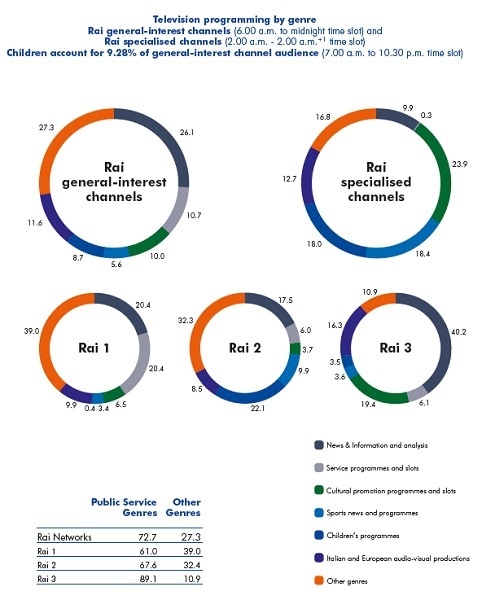home > report on operations > RAI's offering
TV product performance
2011 was characterised by further
growth of the dissemination of DTT. At
the end of the year, the all-digital
regions had become fourteen,
accounting for 78% of the Italian
population.
The most significant effects of the
expansion and diversification of the
television offering include the increase
in the television audience, which
continues the growth trend that, since
2009, has witnessed the media rise to
increasingly higher levels compared to
previous years.
2011 was yet another record year for
viewing figures: for the first time since
the Auditel measuring system was
introduced, more than 10 million
viewers were reached over the whole
day (10.1 million compared to 9.8
million in 2010) while the prime time
audience was of 25.5 million viewers
(25.8 million average viewers, clearly
higher than the previous peaks reached
in 2004 and 2010 in which the
audience reached 25.1 million).
These results are excellent, particularly
because they were achieved in a year
with no big sports events (World and
European Football Cups, Winter and
Summer Olympics) which usually make
a considerable contribution to the
growth of television consumption.
In a competitive and quickly
transforming setting, the Rai Group
continues to confirm its leading role.
On an average day, Rai consolidates
its share with 40.2% di share (-1.1%
compared to 2010) compared to
Mediaset’s 36.3% (-1.3%).
This occurs within the scope of a
general increase in the shares obtained
by specialized satellite or digital
terrestrial channels: excluding the Rai and Mediaset networks measured by
Auditel, the totality of ‘satellite TV
broadcasters’ rises to 11.1% (+1.6
share points on 2009), while ‘Other
terrestrial TV broadcasters’ reach 8.8%
(+0.2%).
The result of the Rai Group is largely
due to the performance of the
specialized channels (‘Rai Specializzate’),
which obtain a total all-day share of
4.8% (with an increase of +1.8 points
compared to 2010), influenced mainly
by Rai 4, Rai Premium, Rai Yoyo, Rai
Movie and Rai News (which more than
doubled its share).
This makes Rai Italy’s first digital
broadcaster, followed by Mediaset
(4.4%), Sky (4.0%), Fox (1.7%) and all
the other Italian and international
competitors such as Discovery,
Switchover Media, Disney, Viacom, and
Turner.
Rai’s general-interest channels, like
those of the competition (apart from
La7), endured a physiological decline,
with the three Rai channels maintaining
their leadership:
• Rai 1 with a share of 18.7% is
confirmed as the most watched
channel and retains its advantage
over the leading Mediaset channel
(-2 points compared to 2010 for both
channels);
• Rai 2 is at 8.2% (-0.9 points) and is
the fourth Italian channel, bypassed
only by Canale 5 and the other two
Rai channels;
• Rai 3 is stable at 8.5% and becomes
the third Italian channel.
In Prime Time the Rai Group confirms
its leadership with a share of 41.3% (-
2.4% compared to 2010) against
Mediaset’s 36.8% (-0.7% points).
The prime time slot has also been
characterised by a growth in ‘Other TV’ to the detriment of the traditional
general-interest offering, with all
‘Satellite TV’ totalling a 9.9% share
(+1.4 percentage points on 2010) and
‘Other terrestrial TV’ climb to 7.5%
(+0.2).
Rai 1 is confirmed as the leading
channel with a 18.9% share and bypasses
Canale 5 by almost two percent
despite the absence in 2011 of
important football events, which
conditioned performance (-3.4 points
compared to 2010, which was
characterised by the World Cup and
during which an Italian team won the
Champions League).
Rai 2 and Rai 3 continue to be the most
watched channels after the leading
channels, with 9.5% (-0.4 points
compared to 2010) and 9.0% (-0.1
points) respectively.
The combined offering of the ‘Rai
Specializzate’ channels reaches a share
of 3.9%, up +1.5 percentage points
compared to 2010.
By the end of the first half of 2012 the
switchover to DTT is expected to be
completed across the whole of Italy.
Between May and June, the analogue
signal will also be switched off in the
Southern Italian regions which have
still to become involved: Abruzzo,
Molise, Apulia, Basilicata, Calabria
and Sicily.
For details on the competitive setting
for the near future, it is interesting to
focus on viewing figures for the ‘all
digital’ regions which, at the end of
2010, had already completed the
switchover to DTT (Piedmont, Valle
d’Aosta, Lombardy, Trentino Alto
Adige, Veneto, Friuli Venezia Giulia,
Emilia Romagna, Lazio, Campania and
Sardinia). These areas, which comprise
about 65% of the Italian population, had a broader television offering than
the rest of the country for the whole of
2011.
The results coming from the ‘all digital’
regions are very positive and prove the
validity of the choices made by Rai.
On the average day, Rai prevails over
Mediaset even more than in the other
areas of Italy: Rai group reaches 40%
against Mediaset’s 35%.
Over the 24 hours, Rai’s three generalinterest
channels have overtaken those
of the direct competition (33.5% against
29.6%).
The ‘Rai Specializzate’ networks, with an
offering on DTT divided over eleven
channels, obtain a total share of 6.6%
and place five channels in the ranking
of the 15 most popular digital
broadcasters (free and pay). Particularly
evident are Rai 4 (1.2%), Rai Premium
(1.1% share) and Rai YoYo (1.0%).















